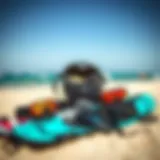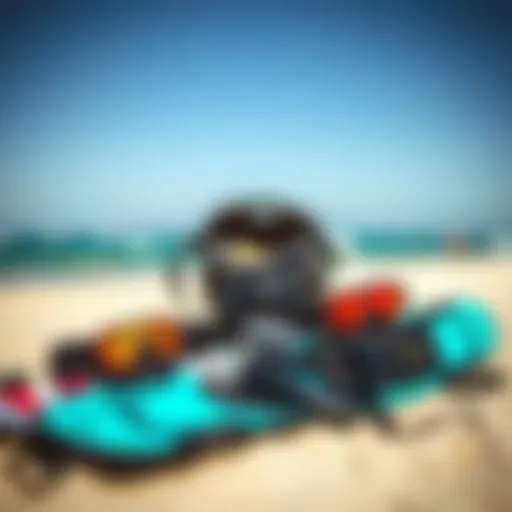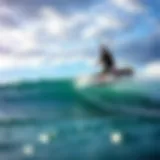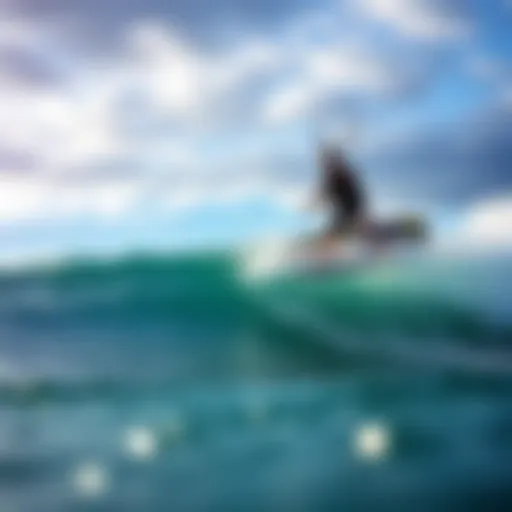Exploring the Dynamics of Pumping Hydrofoil Boards
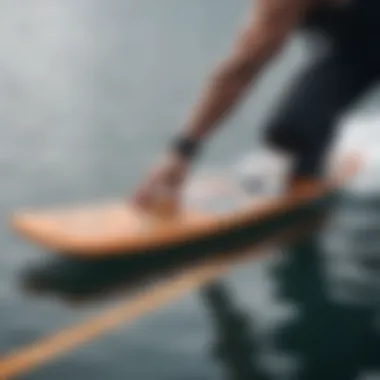
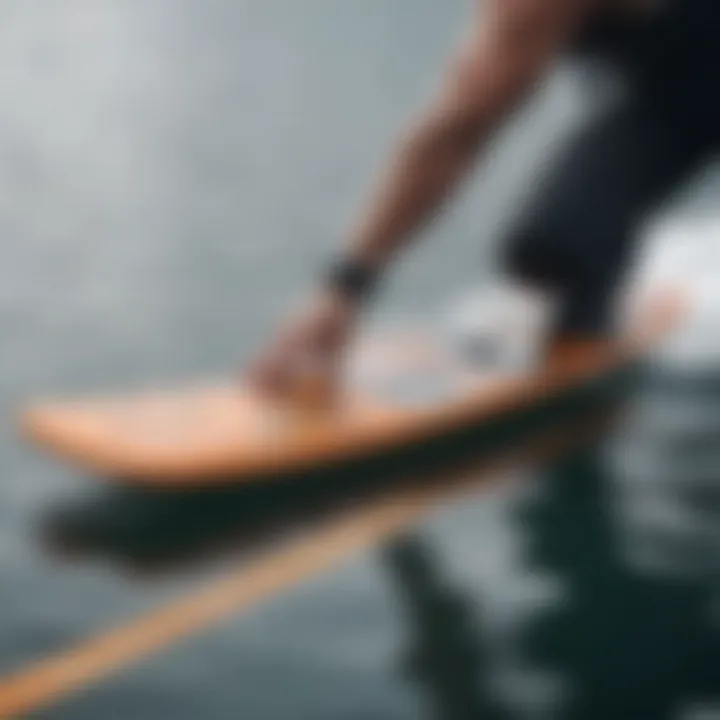
Intro
Pumping hydrofoil boards represent a fascinating intersection of technology and sport. As the understanding of their mechanics is deepened, kiteboarding enthusiasts are never short on intrigue when it comes to discovering how these boards elevate the riding experience. The relationship between rider, board, and water reveals layers of complexity, and unpacking this dynamic not only helps in optimizing performance but also ensures a more enjoyable time spent on the water.
In this guide, we will traverse the intricacies of pumping hydrofoil boards, starting with the essential gear insights. From what to look for when selecting your equipment to the latest reviews of must-have gear, we aim to provide you with a comprehensive understanding of the tools that will enhance your kiteboarding journey. We’ll also delve into techniques and safety practices that elevate your skills while ensuring that enjoyment doesn’t come at the cost of safety.
Prologue to Pumping Hydrofoil Boards
Pumping hydrofoil boards represent a fascinating intersection of engineering, sport, and adventure. Understanding this innovative equipment is essential for anyone involved in kiteboarding, whether you're a seasoned pro or a curious beginner. The mechanics behind pumping hydrofoils are notably complex, yet knowing how they operate vastly enhances the overall riding experience. Moreover, mastering these techniques can substantially improve performance and enjoyment on the water.
The significance of pumping hydrofoil boards lies in their unique ability to generate lift and maintain speed while minimizing drag. This superior balance translates into an exhilarating experience that allows riders to glide effortlessly above the surface of the water, almost as if they are soaring. All this movement isn't just about the thrill; it requires an understanding of the technique, efficient gear selection, and navigating various environmental factors. A grip on these elements assures a safe and effective riding experience.
This article aims to break down the intricacies of pumping hydrofoil boards. By exploring their mechanics, tracing their developmental history, and examining the techniques that make them operate efficiently, readers will gain a fuller grasp of what these boards are capable of. We will delve into the art of pumping techniques, gear considerations, and safety tips that are crucial for anyone looking to navigate the waters confidently. Let's get started by defining what pumping hydrofoil boards actually are.
Defining Pumping Hydrofoil Boards
Pumping hydrofoil boards are specialized kiteboarding boards equipped with a hydrofoil, a wing-like structure submerged in water, which generates lift when the rider gains enough speed. Unlike traditional boards that rely on direct interaction with the water’s surface, hydrofoils eliminate drag, enabling a smoother ride. This efficiency allows riders to harness the kinetic energy from the wind, creating a unique sensation as they skim along the water, transitioning into a state of flying without the need to constantly pull on the kite.
In essence, a pumping hydrofoil board comprises a board connected to a mast and a wing that sits below the water's surface. When the rider pumps the kite and performs specific movements, the angle and speed at which the foil encounters water dictate how easily lift is achieved. Thus, understanding this axial relationship between the wing, water, and rider’s movements is key to maximizing performance.
Brief History of Hydrofoil Development
The journey of hydrofoil development is quite storied, dating back to the early 20th century, when innovators first experimented with the concept. Notably, during the 1960s, American inventor Bob Wood launched the first production hydrofoil, the “HHovercraft,” which was primarily intended for marine vessels rather than boards. This paradigm shifted when various water sport enthusiasts—especially surfers and kiteboarders—recognized the potential for adapting the hydrofoil for recreational use.
The late 1990s and early 2000s marked major advancements with the introduction of hydrofoil kiteboards. With these gains came a surge in popularity as kiteboarding began to capture the interest of thrill-seekers worldwide. As technology progressed, various materials and designs emerged, optimizing both performance and safety.
Today’s pumping hydrofoil boards boast advanced features that enhance buoyancy, stability, and maneuverability, allowing riders to push boundaries previously deemed impossible.
In essence, this historical context not only tells a tale of innovation but also reflects the evolution of kiteboarding itself. Understanding these developments gives riders a richer appreciation for what they experience on the water today.
The Mechanics of Hydrofoils
The mechanics behind hydrofoils are pivotal in understanding not just how they operate, but also how they can significantly enhance performance in water sports. When referring to pumping hydrofoils, there are two critical aspects to consider—the principles of lift and drag, alongside some specific design features that contribute to their overall functionality and user experience. This understanding sets the stage for effective usage and improved skills on the water.
How Hydrofoils Work
Principles of Lift and Drag
The principles of lift and drag form the backbone of hydrofoil functionality. When a hydrofoil moves through water, its design allows it to generate lift, elevating the board above the surface. Lift is created due to the shape of the foil; its curved upper surface and flatter underside cause a pressure difference as water flows over and under it.
Key Characteristics of this principle render it an essential part of hydrofoil dynamics. For instance, the efficiency with which lift is generated is crucial for energy-saving performance. A well-designed hydrofoil minimizes drag while optimizing lift, making it far easier for the rider to glide effortlessly.
However, there are unique features in lift and drag dynamics worth noting. If lift is too high, it can lead to instability, causing the board to bounce or cavitate. This fluctuation can lead to a less enjoyable ride. On the flip side, managing drag well leads to smoother and more controlled maneuvers, essential for advanced techniques like pumping. Finding the sweet spot between lift and drag is key to mastering hydrofoil riding.
Hydrodynamics Explained
Hydrodynamics refers to the study of fluids in motion—in this case, the interaction between the hydrofoil and water. This is not just academic; it has practical implications for anyone looking to optimize their riding experience. Key principles of hydrodynamics can affect everything from turning radius to speed.
A noteworthy characteristic of hydrodynamics in this context is the importance of fluid efficiency. Efficient water flow around the hydrofoil can enhance speed and performance. Riders looking to get the most out of their hydrofoil should pay close attention to how the hydrofoil interacts with water currents and waves.
One distinct feature here is the way water behaves at different speeds. At lower speeds, the drag becomes more prevalent, necessitating different techniques for maintaining lift. Conversely, at higher speeds, a well-tuned hydrofoil can almost skim over the water, greatly reducing drag. Understanding how these dynamics function holistically allows users to optimize their riding style.
Design Features of Pumping Hydrofoils
Design considerations can make or break a hydrofoiler's experience on the water. Not all hydrofoils are created equal, and recognizing the trade-offs involved can aid in making informed decisions.
Materials Used
Material selection is critical when discussing hydrofoils. Manufacturers often use lightweight composites and carbon fiber, combining structural integrity with low weight.
The key characteristics of these materials provide a balance between durability and performance. Lightweight materials enhance responsiveness and agility—vital aspects for skilled riders wanting to execute sharp turns or jumps.
A unique feature of modern materials is that they can often flex or adapt under pressure. This can lead to a smoother ride, as the board may absorb some of the forces from the water. However, disadvantages might include higher costs or lower durability in certain models. Recognizing these aspects is essential for anyone looking into purchasing a new board.
Shape and Size Considerations
When it comes to the physical design of hydrofoils, shape and size are everything. Different shapes can benefit certain riding styles better than others. A wider foil surface can offer increased lift but may generate higher drag. Conversely, a narrower design often translates to speed advancements but can compromise stability.
Key characteristics of shape and size include the lift-to-drag ratio, which in practical terms means that users may need to experiment with different setups to find what works best in their local riding conditions.
One unique advantage of customizing shape is that it allows riders to adjust their performance based on environmental factors. However, the disadvantage lies in the complexity it introduces; not every rider will have the tools or knowledge needed to modify a hydrofoil adequately.
Ultimately, understanding the mechanics behind hydrofoils allows kiteboarders to push boundaries, stay safe, and enjoy a smoother experience on the water. Being vigilant about how these elements function collectively will surely lead to mastery and a deeper appreciation for this exhilarating sport.
"Mastering the mechanics of hydrofoil technology isn’t just about the board; it's about understanding the relationship between rider and water."
Whether you're just dipping your toes in or are a pro, keeping these principles in mind will set you off on the right foot—or rather, the right foil—on your water journey.
Pumping Techniques for Optimal Performance

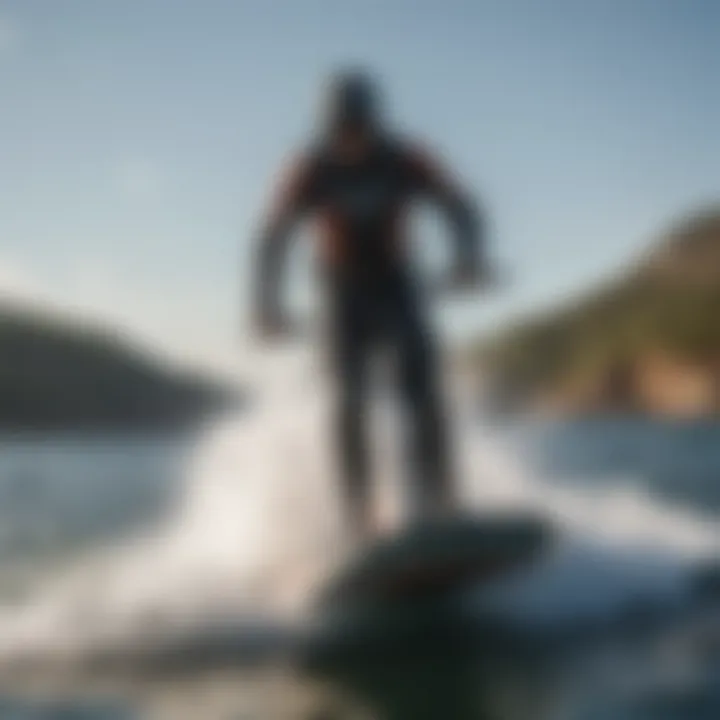
In the world of pumping hydrofoil boards, mastering the right techniques is crucial for getting the most out of this exhilarating watersport. Each maneuver and strategy can profoundly affect one's performance, from initiating the ride to sustaining momentum. Understanding these techniques not only enhances skill but also provides safety and control while riding. These elements form the backbone of an enjoyable experience on the water, giving riders the ability to navigate varied conditions confidently and efficiently.
Initiating the Pumping Motion
Body Positioning
The way a rider positions their body can make or break their performance when starting to pump. Keeping a low center of gravity is key—this means bending the knees and leaning slightly forward. By doing this, the rider stabilizes their frame and prepares to transfer weight effectively. This positioning encourages dynamism and control, allowing for quick adjustments.
A crucial aspect of body positioning is maintaining alignment with the board. When the body is aligned properly with the direction of travel, the rider can more easily harness the lift created by the hydrofoil. Neglecting this element may lead to wobbling, resulting in wasted energy and potential falls. In summary, a strong foundational position is a hallmark of effective pumping:
- Benefit: Improves balance and control
- Consideration: Must be adaptable to varying conditions
Timing with the Kite
Timing with the kite during the pumping initiation is vital. Riders must synchronize their movements with the kite to achieve optimal lift and efficiency. As the kite catches wind, it generates pull—a rider needs to time their pumping to harness this force effectively. Getting this timing right is a game-changer; it turns the kite's energy into motion, enabling the rider to ascend quickly onto the foil.
The primary characteristic of effective timing is rhythm. By developing an innate sense of when to pull against the kite's force, a rider can maintain momentum without exhausting themselves. One drawback, however, is that it requires practice; inconsistent timing can lead to frustrating falls, especially in shifting wind conditions. Still, mastering this art can lead to a fluid, exhilarating ride:
- Benefit: Enhances lift and speed
- Consideration: Requires practice to achieve precision
Sustaining Momentum
Weight Distribution
Proper weight distribution is imperative for maintaining speed on a hydrofoil board. Knowing how to balance weight between the front and back foot can change a rider's experience dramatically. When a rider leans slightly forward, they engage the front of the foil, achieving lift. Conversely, if they lean back, they can slow down or drop back onto the water, losing precious momentum.
This strategic shifting helps to control the board's angle, which greatly impacts speed and stability. Riders often find that subtle adjustments lead to significant changes, highlighting the need for awareness of their body position. The unique feature of this technique is its adaptability depending on conditions—riders can dynamically adjust based on wave patterns or kite pull:
- Benefit: Promotes smoother rides and sustainable speed
- Consideration: Requires constant adjustments for optimal performance
Continuous Pumping Strategies
To ride smoothly, one must dive into continuous pumping strategies. These techniques allow the rider to keep gliding and generating lift without short periods of rest. It involves a rhythmic up-and-down motion—in essence, the rider should continuously generate energy through their pumps while managing the kite's pull responsibly.
One effective strategy is to visualize each pump as a gentle push against the water. This posture encourages a rider to remain fluid and responsive, ensuring they make the most of every pump without it turning into a struggle. However, continuous pumping may tire riders out quickly, particularly beginners. Thus, finding a balance between effort and efficiency is essential:
- Benefit: Maintains speed over longer periods
- Consideration: Can be physically demanding if not performed efficiently
Mastering pumping techniques transforms the experience of hydrofoil boarding, making it not just a sport, but an art form.
By honing these techniques, riders elevate their kiteboarding game—whether they are novices or seasoned veterans. Pumping hydrofoil boards offer vast potential for both enjoyment and performance, making an understanding of these mechanics indispensable for anyone looking to make waves in this thrilling sport.
Safety Considerations
Safety considerations are paramount when engaging with pumping hydrofoil boards. With the thrilling nature of kiteboarding, it's easy to get swept away in the excitement, but overlooking safety can lead to serious consequences. Hence, understanding the risks and implementing precautions can greatly enhance both personal safety and enjoyment of the sport.
Understanding Risks and Precautions
Equipment Checks
Equipment checks form the backbone of safety in hydrofoil boarding. Before setting out on the water, giving your gear a once-over is crucial. This involves inspecting the kite, lines, and board for any signs of wear or damage. Many accidents stem from unnoticed wear-and-tear, making this check essential. A well-maintained setup not only increases performance but also keeps you safer on the water.
A key characteristic of comprehensive equipment checks is that they instill confidence. Knowing that all components are in tip-top shape allows for better focus on the riding experience rather than worrying about potential gear failure. Although this can become a habit that many adopt, the consistent practice of equipment checks ensures that necessary repairs or replacements are addressed timely which, in the long run, is a smart choice. A unique advantage of these checks is their simplicity; with a few moments dedicated beforehand, riders can feel secure and prepared.
Proper Spotting Techniques
Proper spotting techniques are another critical aspect in the world of hydrofoiling safety. This means having someone on the shore or in the water able to keep a watchful eye on the rider. Their role is to provide guidance or assistance if needed. This practice is especially important for beginners or those trying new maneuvers.
The main advantage of proper spotting lies in the safety net it creates. Having a reliable buddy system not only helps in emergencies but can also contribute to improving skills. Spotters can offer immediate feedback on technique, which is especially beneficial in a sport where split-second decisions are vital. However, it's important to ensure that the spotter is knowledgeable about the sport; otherwise, they may not be able to react appropriately in high-pressure situations.
Emergency Protocols
Emergencies can arise unexpectedly, and having a solid plan in place is essential. That's where emergency protocols come in. It focuses on defining specific steps to take during critical situations, enabling individuals to respond swiftly and effectively.
Self-Rescue Techniques
Self-rescue techniques are vital for kiteboarders. Understanding how to regain control during challenging situations can make a world of difference. In essence, it involves knowing how to manage the kite if you fall or end up in turbulent waters. The utility of such techniques cannot be overstated; they empower the rider to take charge of their safety, irrespective of their surroundings.
A standout feature of self-rescue is its adaptability. Riders can tailor techniques based on personal experience and environmental conditions, enhancing effectiveness. Moreover, mastering these skills builds confidence, making participants more resilient on the water. However, it demands practice and familiarity with various techniques, which may be a barrier for some.
Dealing with Wind Changes
Wind is arguably the most unpredictable factor in kiteboarding. Understanding how to navigate sudden shifts can be the difference between a routine day on the water and a dangerous situation. Riders need to assess the weather conditions and predict changes to their advantage.
The significance of knowing how to deal with wind changes is immense. Quick comprehension of wind patterns and adjusting accordingly ensures sustained performance and safety. A unique feature of this knowledge is the ability to read the environment effectively. Winds can shift rapidly, but with experience, riders can better anticipate these changes and adjust their kite position accordingly. While this knowledge is hugely beneficial, it requires time spent on the water, consistently adapting to the ever-changing conditions.
Remember: Safety isn't just a checklist; it's a mindset. Prioritizing safety measures—like equipment checks, spotting, and understanding emergency protocols—can genuinely transform your kiteboarding experience.
Gear Selection for Pumping Hydrofoils
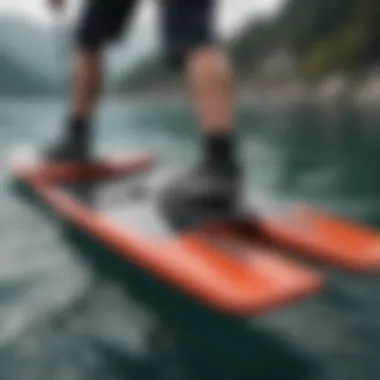
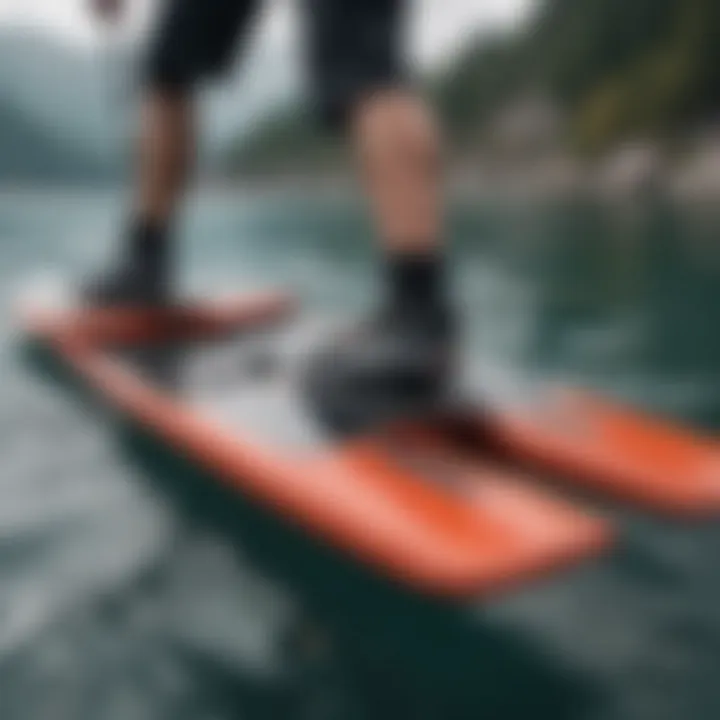
Selecting the right gear is paramount when it comes to pumping hydrofoil boards. The type of board and kite you choose can either elevate your experience on the water or lead you to a frustrating afternoon, battling poor performance. Gear selection helps to ensure that your time on the water is not just enjoyable but also tailored for the conditions you face.
Choosing the Right Board
Different Types of Hydrofoil Boards
When it comes to hydrofoil boards, one isn't simply another. There's an array of different styles, each shining in specific applications. Among them are surf hydrofoils, dedicated kite foils, and even wakeboarding foils.
A surf hydrofoil board, for example, often features a more prominent rocker and is typically wider at the nose. This design helps in catching waves while maintaining lift as you pump through the swell. On the other hand, kite foils tend to be more elongated and streamlined, optimized for stability and speed in the air, which becomes essential when wind conditions vary.
Key Characteristic: The construction of the board is significant. Many of these boards are made with lightweight materials like carbon, which enhances performance but can also lead to a hefty price tag.
Choosing the right type of hydrofoil board is a beneficial move that aligns with your riding style and terrain. For instance, a dedicated kite foil board allows for more agility and responsiveness when matched with a suitable kite.
Performance Features to Consider
When weighing up performance features, it's critical to consider aspects such as buoyancy, stability, and ability to disrupt drag efficiently. A board's buoyancy affects how well it can lift out of the water during the pumping motion. The more buoyant the board, generally, the less effort you put into initiating lift.
Unique Feature: Look for boards designed with adjustable foils or removable wings which lend flexibility for various water conditions.
One downside to consider is that increased buoyancy might result in a slower ride in certain conditions. Riding a board optimized for buoyancy in high-wind situations can lead to over-lifting, causing instability.
Matching the Kite with the Hydrofoil
Kite Size and Performance
A kite's size can directly affect performance, potentially making or breaking your session on the water. Larger kites generate more power but can be cumbersome to control, especially in choppy waters. On the flip side, smaller kites are easier to handle but may struggle in light wind conditions.
Key Characteristic: The relationship between your kite and hydrofoil board's performance becomes essential, especially for transitioning smoothly from off the water to flying. For those looking to maximize efficiency, choosing the right kite size can allow for optimal lift and the ability to pump through lulls.
Unique Feature: Riders often experiment with different kite sizes to find a sweet spot that balances power and control to ride efficiently without sacrificing safety. This tinkering reveals which setups feel most comfortable under varying conditions.
Wind Conditions and Board Interaction
Understanding how wind affects the interaction between the kite and board can substantially boost your performance. Wind speed and direction alter how lift is generated on the hydrofoil, impacting your overall ride.
Key Characteristic: It’s crucial to read conditions and adjust your setup accordingly. For instance, if it’s a gusty day, you might find that decreasing kite size is more beneficial than sticking with a bigger one.
Unique Feature: The alignment of your hydrofoil design relative to riding direction also affects performance. Boards designed with specific wing shapes can help focus lift in diverse wind conditions, leading to smoother rides.
This careful selection of gear creates a personalized experience on the water and enhances the overall adventure.
"Matching your kite and board isn’t just about personal preference; it’s about adapting to the natural elements around you."
By taking the time to understand the nuances behind each component of your gear, you can set yourself up for a rewarding time conquering the waves with your pumping hydrofoil.
The Role of Environmental Factors
Understanding environmental factors is key to truly grasping the dynamics of pumping hydrofoil boards. While mechanical design and riding techniques are important, one cannot overlook how water and weather conditions dramatically influence the activity. These factors not only affect performance but also play a significant role in safety and overall enjoyment. In this section, we break down the influence of water conditions alongside several weather parameters.
Influence of Water Conditions
Wave Patterns
Wave patterns can make or break a session on the water. The specific aspect here revolves around how these patterns form and interact with your hydrofoil board. For instance, riders often prefer smaller, more manageable waves. They are easier to navigate and allow for agility while pumping. The unique feature of these smaller waves lies in their ability to provide consistent momentum without the need for extreme paddling or energy expenditure.
However, larger waves present both challenges and opportunities. While they can provide a thrilling ride, they might also create excessive drag, which can hinder lifting and stability. On the flip side, catching the right wave at the right angle can amplify your lift and help maintain speed, proving beneficial for those experienced in reading and adapting to changing surf.
Tide Effects
Tide effects play another pivotal role in hydrofoil performance. When considering tide cycles, it’s crucial to pay attention to how the tide will impact the depth of the water where you're riding. A high tide can create ideal conditions, filling in shallow areas and allowing enough depth for the hydrofoil to operate efficiently. Moreover, during high tide, current flows can also become more favorable.
On the other hand, low tide often leads to a more challenging environment. Many areas can become too shallow, leading to potential complications with drag and control. Navigating these conditions requires adaptation. Thus, understanding the local tide charts and their timing helps you prepare and get the best out of your hydrofoil experience.
Weather Conditions Overview
Wind Speed and Direction
The intricacies of wind speed and direction significantly shape your hydrofoiling venture. First and foremost, the wind acts as a primary propulsion force when using a kite. Too little wind can render kiting ineffective, creating frustrating experiences on the water. Conversely, high winds can overwhelm a rider, requiring advanced skill to navigate safely. This is why many practitioners recommend finding a sweet spot within moderate wind ranges—often somewhere between 15 and 25 knots.
Additionally, wind direction can change the dynamics of your ride. Crosswinds can create instability, while onshore winds might offer a smoother experience. Experienced kiters often learn to read wind patterns, adapting their riding styles to mitigate challenges. This added skillset can mean the difference between a stellar session or a rather troublesome one.
Temperature Considerations
Temperature considerations aren’t just about comfort; they play a significant role in material performance and rider endurance. Warm temperatures often enhance the mobility of the rider along with the flexibility of the materials used in hydrofoil designs. Lighter, more responsive boards found in warmer weather can elevate your overall performance. Moreover, knowing the temperature patterns can help in gearing up appropriately—layering to maintain warmth without hindering movement.
However, extreme heat can lead to fatigue, so it’s beneficial to monitor how long you spend in the sun. Hydration and rest become paramount, especially when temperatures soar. Conversely, in colder climates, riders might need to pay closer attention to their gear, making sure everything is functional in potentially harsher conditions.


"Weather conditions dictate the performance terrain—a wise kiter learns to read the elements and adapt.”
Sharing Experiences in the Kiteboarding Community
The kiteboarding community stands out as a vibrant and supportive ecosystem where many enthusiasts gather to exchange stories, tips, and insights. Sharing experiences in this space is more than just relaying personal tales; it is about building a collective knowledge base that helps both newcomers and seasoned riders alike navigate the complexities of various techniques, gear choices, and safety measures. Connections formed through shared experiences foster a sense of belonging and can greatly enhance one’s journey in the world of pumping hydrofoil boarding.
User-Generated Stories and Tips
User-generated stories serve as a treasure trove of knowledge. Every rider has encountered different conditions, varying challenges, and unique victories. These narratives often contain gems of advice that aren’t readily available through traditional instructional manuals or courses. For example, one might share a story about an unexpected wind shift and how they adapted their technique to maintain stability. Here are a few ways these stories benefit the community:
- Real-Life Scenarios: Stories illustrate practical applications of techniques in a variety of conditions, making theoretical concepts more relatable.
- Inspirational Moments: Hearing about someone overcoming obstacles can encourage others to push through their own struggles.
- Safety Tips: Sharing near-miss experiences can highlight potential dangers, educating others on how to avoid similar situations.
One such story from a rider in Puerto Rico talks about a day when they encountered stronger winds than expected. They describe how they shifted their weight to counterbalance the force, a simple yet crucial adjustment that made a big difference.
Building Connections through Shared Knowledge
The act of sharing personal experiences leads to deeper connections among kiteboarders. Whether through a local meetup, forums on platforms like Reddit, or dedicated Facebook groups, these conversations hold great value in establishing a network of support.
The benefits of building connections through shared knowledge include:
- Skill Improvement: Learning from others' experiences accelerates one’s own development, allowing riders to refine their techniques based on peer feedback.
- Community Building: As people share their stories, they create a sense of camaraderie, which can enhance the enjoyment of the sport itself.
- Resource Sharing: Experienced riders often point newcomers toward useful resources such as educational videos or articles, expediting their learning process.
Most importantly, these connections enrich the kiteboarding experience, turning solo adventures into a communal journey where riders can celebrate successes and navigate challenges together. In a world where personal interactions are sometimes overshadowed by digital distractions, the kiteboarding community continues to be a beacon of support and shared passion.
Future Trends in Hydrofoil Technology
In the fast-evolving world of water sports, hydrofoil technology is not just keeping pace but leading the charge. Understanding future trends in hydrofoil technology is essential for kiteboarders seeking to maximize their performance and enjoyment on the water. As the sport increasingly gains traction, innovations promise to redefine the experience of riding a hydrofoil board. Adaptations in materials and the integration of smart technology have become focal points for enhancing the efficiency and sustainability of hydrofoils. This section lays out key advancements that are shaping the future of pumping hydrofoil boards, underscoring the significance of innovation in the sport’s growth.
Innovations on the Horizon
Material Advancements
Material advancements in hydrofoils are at the forefront of improving performance. Manufacturers are now leaning towards stronger yet lighter materials, such as carbon fiber and infused composites. Not only do these materials provide durability, but they also enhance lift and reduce drag, crucial elements for any hydrofoil rider aiming for high speeds and efficient gliding.
A key characteristic of this innovation is its feather-light nature, which allows for more responsive control during rides. With boards weighing less, riders can experience less fatigue over longer sessions on the water. Furthermore, the strength of these materials ensures that hydrofoils can withstand the rigors of frequent usage – no one wants to end up with a cracked or warped board mid-session.
Unique features like advanced layering techniques allow for even greater flexibility without sacrificing structural integrity, which translates into smoother rides. However, one must consider that high-tech materials often come with a heftier price tag, which could be a barrier for some enthusiasts. Ultimately, the choice of materials plays a significant role in the performance and overall experience of riding a hydrofoil.
"The right materials can turn an average session into a memorable one, changing how we define our limits on the water."
Smart Hydrofoil Systems
Smart hydrofoil systems are another innovative leap making waves in the hydrofoil community. These sophisticated setups include sensors and software designed to provide real-time feedback on performance metrics such as speed, angle of attack, and even battery levels in electric models. The ability to gather and analyze data while riding opens up new avenues for boosting technique and performance.
The standout feature of smart hydrofoil systems is their adaptability; they can adjust automatically to changing conditions, allowing for an optimized experience regardless of environmental factors. This responsiveness not only enhances performance but also provides a safety net for riders, ensuring they can focus on enjoying their ride.
On the downside, integrating smart technology does raise concerns about maintenance and repair costs, which could be higher than traditional models. Given the complexity of these systems, users may need to possess a certain level of tech-savvy to troubleshoot issues when they arise. Nonetheless, the advancements and benefits offered through smart hydrofoil systems highlight a promising direction for the future of kiteboarding.
Sustainability in Hydrofoil Production
As the kiteboarding community grows, the conversation around sustainability becomes ever more critical. The push towards eco-friendly practices in hydrofoil production is gaining momentum, which can’t be overstated. The impact of materials choice and manufacturing processes on the environment must be taken into account as more enthusiasts engage with this exciting sport.
Eco-Friendly Materials
Using eco-friendly materials in hydrofoil production can significantly lessen the environmental footprint of the sport. Sustainable choices, like recycled plastics and bio-based composites, are becoming more sought after. This is not only beneficial for the planet but often results in lighter boards with excellent flexibility.
The crucial aspect of eco-friendly materials is their ability to balance performance with sustainability. Many manufacturers have begun experimenting with forest-friendly resources that don’t compromise on the ride quality. While some eco-friendly options might initially seem less durable, continual improvements mean they are becoming increasingly reliable. The proactive shift towards greener materials shows the industry's commitment to a sustainable future.
Reducing Environmental Impact
Reducing environmental impact in hydrofoil production includes minimizing waste during manufacturing and ensuring that production processes adhere to sustainable practices. It's about focusing on efficiency, both in terms of materials used and energy consumed during production.
A key characteristic of this approach lies in the emphasis on life cycle assessments; manufacturers evaluate the environmental impacts of their products from inception to disposal. The goal is to create boards that not only last through rigorous use but that can also be recycled or disposed of in an environmentally responsible manner afterward.
While transitioning to greener practices often involves additional costs and adjustments in traditional production methods, the long-term benefits to the environment and the reputation of the sport are invaluable. Being environmentally conscious is increasingly becoming a priority for consumers, especially in action sports where nature is the backdrop for every ride.
In sum, the future of hydrofoil technology is not just about enhancing performance; it is a fusion of innovation and sustainability that has far-reaching implications for the sport and its community.
Engaging with these trends can inspire kiteboarders to seek out gear and practices that reflect a more responsible approach to riding, proving that enjoyment on the water can happen with consciousness about preserving it.
Epilogue and Final Thoughts
In the realm of kiteboarding, understanding pumping hydrofoil boards is not just a matter of engaging with an exciting sport; it’s about grasping the very mechanics that elevate the experience on water. The conclusion of this article brings everything to a head, summarizing critical insights that can not only enhance performance but also enrich safety and enjoyment on the water. By diving deep into the intricacies of hydrofoil mechanics, techniques, and environmental factors, this article lays a solid foundation for kiteboarders, instructors, and enthusiasts alike.
Summary of Key Points
- Hydrofoil Mechanics: The article explored how hydrofoils create lift through both the principles of physics and strategic design. Understanding lift and drag—and how they interact—can optimize a rider’s performance.
- Pumping Techniques: Techniques for initiating and sustaining the pumping motion were discussed, emphasizing correct body positioning and weight distribution. Each element is crucial for maximizing the hydrofoil's potential.
- Safety Precautions: The discussion of safety considerations underscored the importance of being aware of risks and having emergency protocols. Knowledge in these areas can be the difference between a successful outing and a dangerous situation.
- Gear Selection: Tailoring gear to suit style and environment really boosts performance. Matching the right board and kite to specific conditions sets the stage for successful rides.
- Environmental Factors: Finally, grasping how weather and water conditions influence hydrofoiling is vital. This context allows kiteboarders to plan their sessions better and adjust strategies on the fly.
Encouraging Exploration and Knowledge
As we wrap this discussion, it’s worth noting that knowledge is an adventure in itself. The insights gained from mastering pumping hydrofoil mechanics not only enhance your practical skills but also broaden your appreciation of the sport’s intricacies.
Call to action: For every kiteboarder or curious mind, continue the exploration. Engage with your community—share experiences, dive into user-generated stories, and seek out knowledge. Whether through forums on reddit.com, or community pages on facebook.com, there are endless avenues for learning and connection.
Every session on the water presents new challenges and opportunities. Embrace every moment and let the evolution of your craft unfold organically, as knowledge and passion intertwine.










